秒词邦
分题型分考点背单词 文
文 文
文
6月27日上午,今年湘江第三号洪峰已安全过境长沙。洪峰水位37.14米,超警戒水位1.14米。此轮洪水过程中,水位涨幅达5.4米。
水文部门预计,长沙站将于6月28日10时左右退出警戒水位。沿线值守人员正严阵以待。
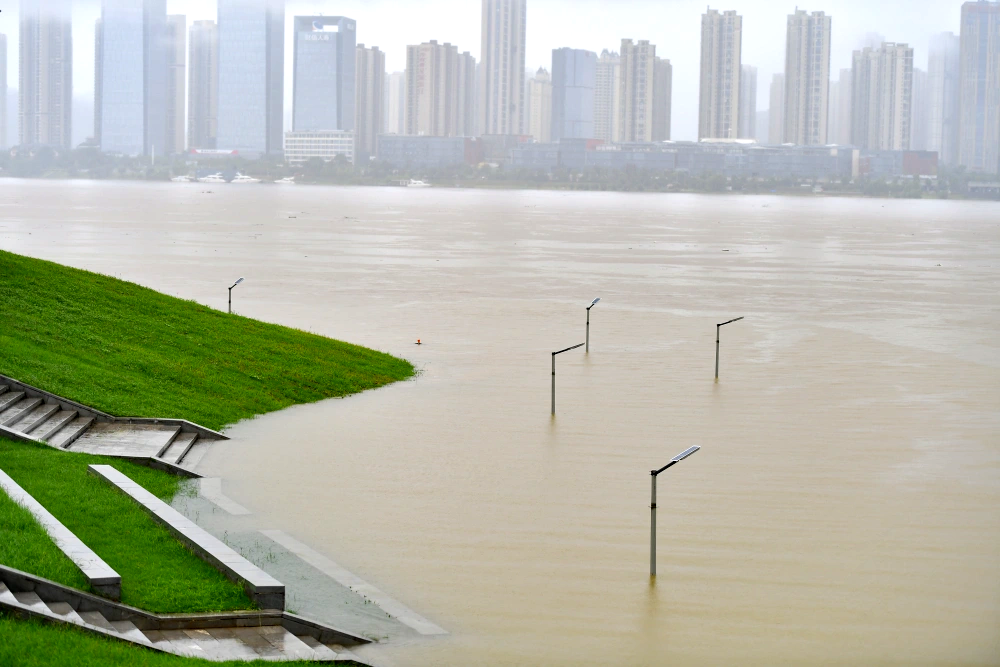
▲6月26日,长沙北辰三角洲沿岸观光平台被江水淹没。(图源:新华社)
而100公里外的资水桃江水文站,6月27日9时55分水位涨至警戒水位39.20米,达到洪水编号标准,资水2024年第2号洪水形成。
汛情、雨情形势,容不得我们有丝毫松懈。
据气象部门预报,7月3日之前,强降雨中心仍位于长江中下游附近地区。就湖南而言,未来一周,降雨仍集中在湘中、湘北,6月27日至29日,湘西、湘北部分地区有大到暴雨,局地大暴雨。资水下游、澧水、洞庭湖区可能出现超警洪水。
“清醒认识当前严峻形势,把防汛抗灾工作作为当前压倒一切的重要任务。”6月25日,在全省防汛抗灾工作视频调度会议上,省委书记沈晓明这样强调。
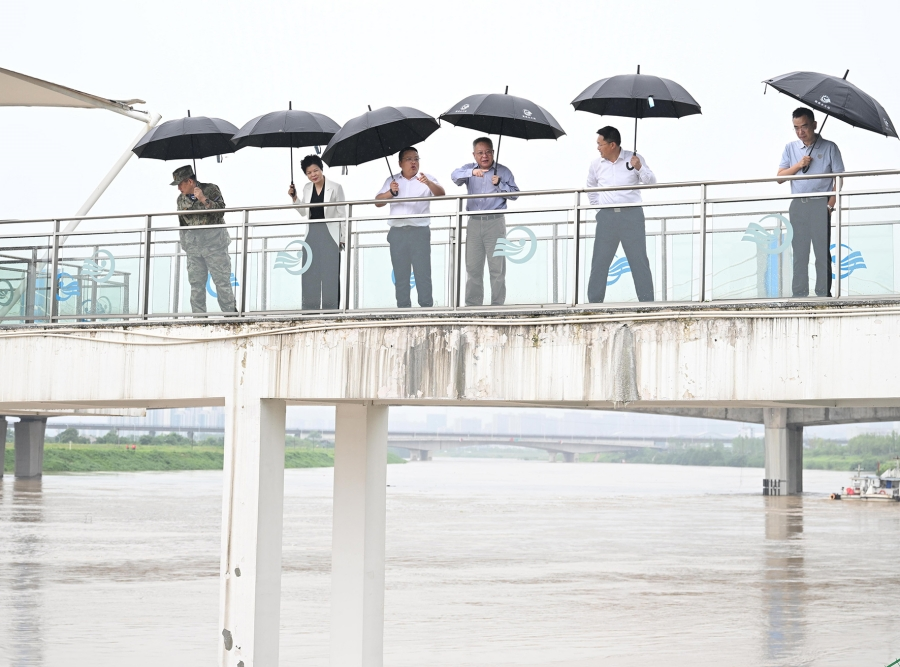
▲6月26日,沈晓明在长沙浏阳河㮾梨水文站察看水情。(图源:湖南省人民政府门户网站)
6月26日下午,沈晓明在长沙市检查调度防汛抗灾工作,并在省水利厅召开防汛会商会。他强调“全力以赴打好防汛抗灾这场硬仗”。
接连两天,沈晓明连续召开会议进行部署,并来到浏阳河和湘江的水文站,现场了解水情,省长毛伟明等多位省领导分赴市州指导检查防汛抗灾工作,传递了当前防汛压倒一切的责任感和紧迫感。
在人工智能时代,如何打好防汛抗灾这场硬仗?从最近防汛的情况来看,不仅要依靠“硬核”的现代技术,更需要有啃“硬骨头”的精神。
防汛“黑科技”正越来越多。
在充分发挥人的主观能动性基础上,借助科技的力量,湖南在应对“水”这件事上,是费了心思、想了办法的,层出不穷的防汛“黑科技”就是生动例子。
比如,预报得更准。 在防汛工作中,对气象的精准、及时预报非常重要。
“依托科技力量,我们强化精准预判水平。”省气象台智能网格预报科科长徐靖宇表示。
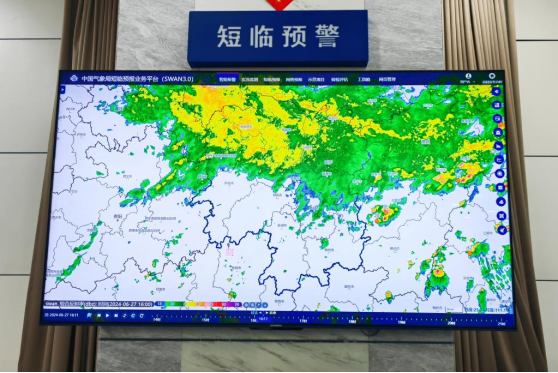
▲6月27日下午,观潮君在现场看到,湖南省气象台采用中国气象局短临预报业务平台(swan3.0)实时更新雷达数据。
观测能力方面,基于三维立体气象观测网,运用多普勒天气雷达、区域自动气象站、气象卫星等采集实况资料,通过对海量数据的收集整理及复杂的加工处理,形成精确到分钟级、公里级的实时气象观测站点数据及网格数据。
预报能力方面,基于人工智能预报等技术手段,结合海量观测数据,通过超级计算机的复杂计算,来预测未来10天的天气形势。
“不仅如此,利用分钟级的数据计算,结合天气雷达外推技术,能够实时完成对未来2小时内精确到乡镇级别的短临预报。”徐靖宇解释。
比如,“看”得更广。 过往,提到天网摄像头,我们都会潜意识联想到公安系统。事实上,天网摄像头在防范城市内涝上也能大显身手。
“遍布长沙大街小巷的30万个天网摄像头,对城区主干道积水点、内涝点监控全覆盖。”长沙市城区排水事务中心工作人员陈泽明介绍,这样能及时、精准发现积水点,便于第一时间处置。
不仅是城区,在偏远山区,基于远程视频技术,能登高望远的铁塔“哨兵”同样功不可没。
数据显示,6月19日至25日,遍布全省的2万多个铁塔视频站点实时监测“汛息”,共智能发现河湖汛情112处、山体滑坡5处。
比如,排得更快。 湖南防汛用上了有着“吃水大王”之称的排水抢险车,能在短时间内,让城市不受“内涝之苦”。
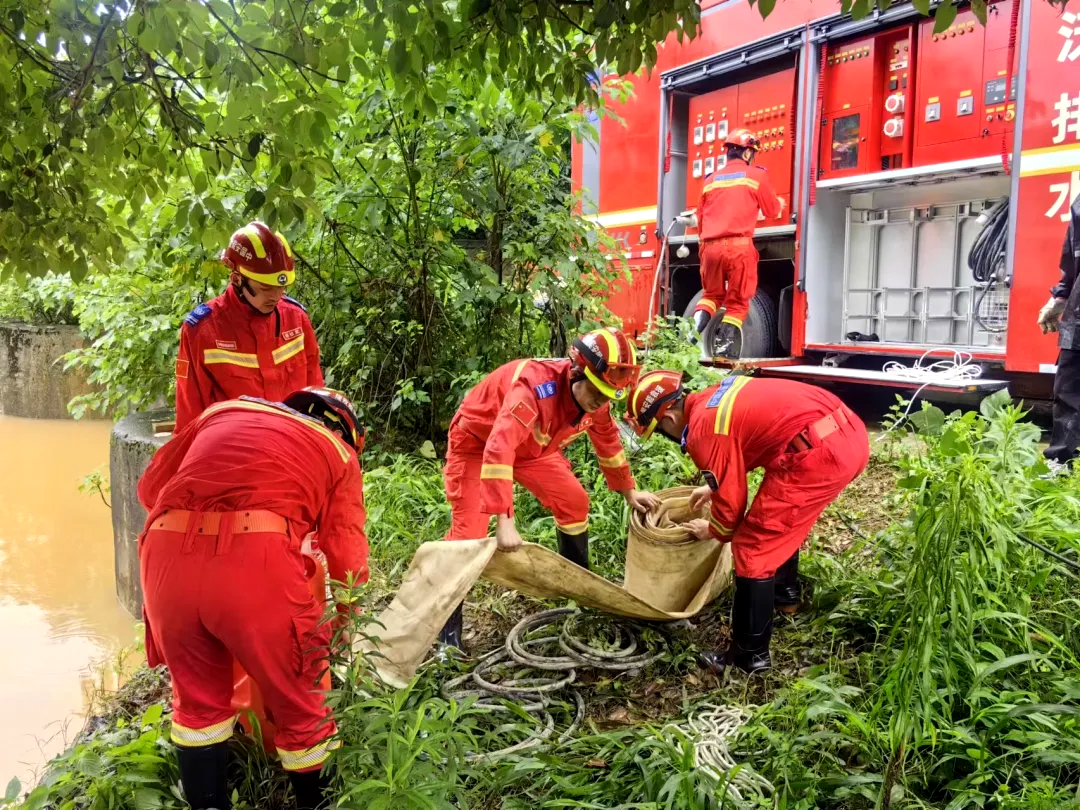
▲排水抢险车在长沙枫树山南屏锦源小学东侧水塘排涝。
中国安能长沙救援基地的排水抢险车,最大排水量可达每小时6400立方米。本轮强降雨,该基地先后在万家丽高架、长沙大道南地下通道、雨花大道阳光城地下车库等地进行排涝作业。
有些“土办法”还是要用起来。
虽然科技进步了,极大提高了监测、预警效率,但并不意味着过去行之有效的一些做法就要退出历史舞台。因为很多“土办法”,是经过无数实践形成的行之有效的经验总结。

▲安化县东坪镇百选村在防汛期间还通过敲锣进行预警。(资料图)
比如敲锣行动。 短信通知、群里预警固然高效,但受极端天气等因素影响,容易出现信号不稳定、通知不到位的情况。
而在夜间,尤其是凌晨,人的警惕性最低的时候,仅靠“一键发布”显然不够。
这种时候,村村响、敲锣、吹口哨等“大阵仗”“大响动”的示警方式则更为直接有效,也更能给人带来紧迫感,激起危机意识。
6月21日至22日,桃源县遭遇历史罕见特大暴雨,郑家驿镇游鹿溪村处于暴雨带中心。凌晨时分,该村老屋坪组的老党员黄治国就是靠着敲铜锣、吹口哨,组织村民安全转移的。
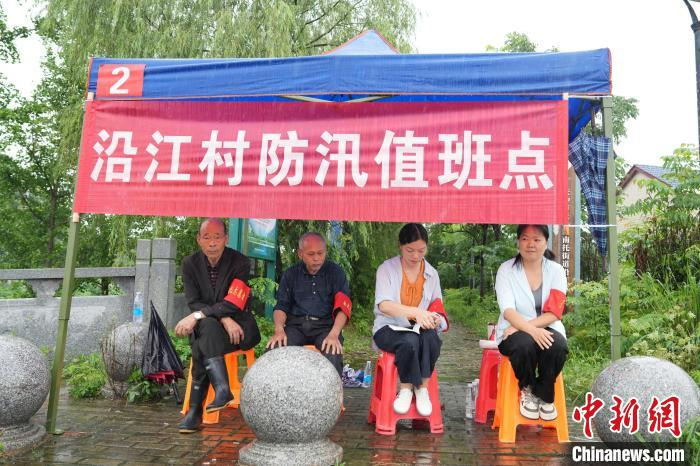
▲6月26日,长沙市天心区沿江的河堤上,街道工作人员和村民24小时轮岗值守排查险情。(图源:中新网)
比如蹲守值班。 这是湖南最常见的防汛操作之一,通过人工盯防的方式,时刻关注水情变化,并排查堤坝上可能存在的管涌、局部塌方等风险,及时做出反应。
这种志愿或者义务形式的值班值守,能够极大地调动和激发大家保卫家园的积极性和主动性。保持对大自然的敬畏,团结一心自领责任,才是我们对抗自然灾害最大的底气。
6月22日,当浏阳河的水位超过36米警戒线时,雨花区黎托街道托溪社区居民就自发组织起来,与社区工作人员和志愿者一同投入到紧张的巡视护堤工作中,成为了浏阳河畔的“守护者联盟”,24小时接力守卫家园。
而在洞庭湖区、湘江沿岸、资水等防汛一线,这样点位不计其数。例如长沙城区湘江两岸,每隔几百米就设置了一个防汛值守点,街道和社区工作人员24小时在此值守。
比如“挪床行动”。 湖南是全国地质灾害最严重的省份之一,截至2023年底,全省共有地质灾害在册隐患点18570处,威胁人口70.87万。而地质灾害多在夜间发生,以摧毁房屋后墙为主,所以一楼后屋的床铺往往是最危险的。
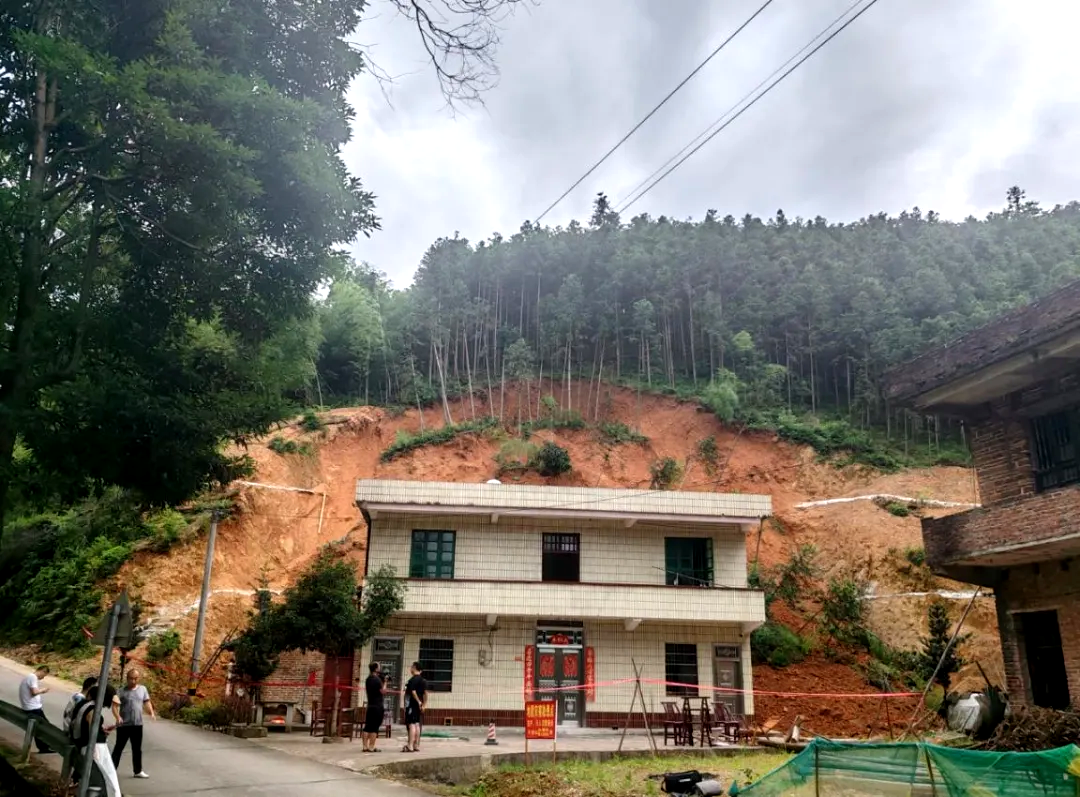
▲6月23日,常宁市黄江村这处滑坡中的6人成功提前转移避险。从画面可看到,前屋比后屋相对更安全。(图源:“湖南应急管理”微信公众号)
4月1日,湖南进入汛期的第一天,省自然资源厅向各地下发了《关于进一步做好地质灾害防御工作的紧急通知》,这个通知里,就明确乡镇、村组干部和群测群防员要逐户上门推动实施“挪床行动”。
挪床怎么挪?其实就两句话,“睡楼上不睡楼下、睡前屋不睡后屋”。挪床办法虽然“土”,靠山住户在汛期如果避开此区域,将会大大降低灾害风险。
“挪床行动”,也挪出了成效。例如,4月23日和4月30日,岳阳就先后成功避险2起;张家界今年以来已成功避险6起。
最关键的,还是在于人的“双脚”。
6月26日,湖南省减灾委员会办公室发布通报,对近期12起成功避险案例予以通报表扬。
比如,6月24日9时许,长沙市雨花区井湾子街道工作人员在巡查时,发现长沙民政学院一栋学生公寓东北侧山体局部有松土掉落现象。上报后,雨花区及时转移学生400余人。10时许,护坡发生垮塌,但由于处置及时,避免了人员伤亡和财产损失。
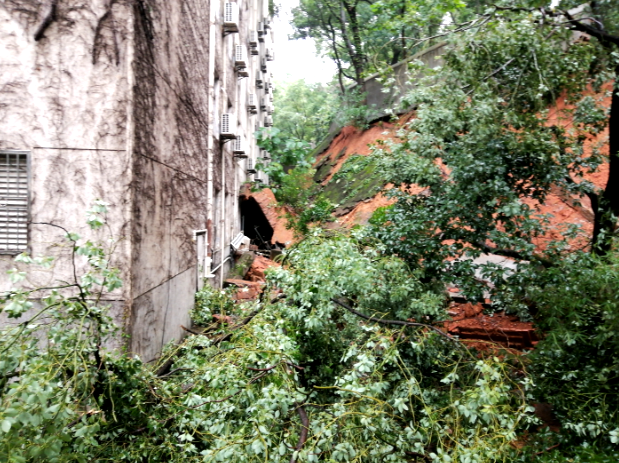
▲长沙民政学院学生公寓后的山体滑坡现场。(图源:“湖南应急管理”微信公众号)
从这一批成功避险案例中,观潮君发现一个共性,都是通过“双脚”的巡查,及时发现隐患,并及时上报、及时处置,从而避免了悲剧发生。
虽然越来越多的防汛“黑科技”正在被应用,但要适应和吃透大自然的复杂性,仍需要时间。
先进的技术、科学的制度,最终都是要靠人来落到实处发挥效果。换句话说,就是防汛不仅仅要防洪水猛兽、次生灾害,更要防人的麻痹思想、粗心大意,以及防危机意识和责任意识淡薄。
当前,或许人的“双脚”仍是最靠谱的,只有该查的地方查到位,该报的内容报及时,该处置的时候够果断,才能真正防患于未然,打好防汛抗灾这场硬仗。
In the era of artificial intelligence, flood prevention still requires "two feet"
On the morning of June 27th, the third peak of the Xiangjiang River this year has safely passed through Changsha. The peak water level is 37.14 meters, exceeding the warning water level by 1.14 meters.
The hydrological department predicts that Changsha station will exit the warning water level around 10:00 on June 28th. The on duty personnel along the line are on standby.
At 9:55 am on June 27th, the water level at the Taojiang Hydrological Station in Zishui, 100 kilometers away, rose to the warning level of 39.20 meters, meeting the flood identification standard. The second flood of Zishui in 2024 was formed.
The flood and rain situation cannot tolerate any relaxation from us.
According to the meteorological department's forecast, before July 3rd, the center of heavy rainfall was still located near the middle and lower reaches of the Yangtze River. As far as Hunan is concerned, in the coming week, the rainfall will still be concentrated in central and northern Hunan. From June 27 to 29, there will be heavy to rainstorm in western and northern Hunan, and local heavy rainstorm. Downstream of Zishui River, Lishui River, and Dongting Lake area may experience excessive flood warning.
"We must have a clear understanding of the current severe situation and make flood prevention and disaster relief work the most important task at present." On June 25th, at the video conference on flood prevention and disaster relief work in the province, Shen Xiaoming, Secretary of the Provincial Party Committee, emphasized this.
On the afternoon of June 26th, Shen Xiaoming inspected and dispatched flood prevention and disaster relief work in Changsha City, and held a flood prevention conference and chamber of commerce at the Provincial Department of Water Resources. He emphasized "making every effort to fight the tough battle of flood prevention and disaster relief".
For two consecutive days, Shen Xiaoming held meetings to deploy and went to the hydrological stations of Liuyang River and Xiangjiang River to understand the water situation on site. Provincial leaders such as Governor Mao Weiming went to cities and prefectures to guide and inspect flood prevention and disaster relief work, conveying the overwhelming sense of responsibility and urgency of current flood prevention.
In the era of artificial intelligence, how to fight the tough battle of flood prevention and disaster relief well? From the recent situation of flood prevention, it is not only necessary to rely on modern technology with a "hard core", but also to have the spirit of tackling "hard bones".
The number of "black technologies" in flood prevention is increasing.
On the basis of fully exerting human subjective initiative and leveraging the power of technology, Hunan has put in a lot of effort and thought of ways to deal with the issue of "water". The emerging flood control "black technology" is a vivid example.
For example, predicting more accurately. Accurate and timely meteorological forecasting is crucial in flood prevention work.
"Relying on technological strength, we strengthen the level of accurate prediction," said Xu Jingyu, the head of the intelligent Grid Forecasting Department at the Provincial Meteorological Observatory.
In terms of observation capability, based on a three-dimensional meteorological observation network, Doppler weather radar, regional automatic meteorological stations, meteorological satellites, etc. are used to collect real-time data. Through the collection, organization, and complex processing of massive data, real-time meteorological observation station data and grid data accurate to minute and kilometer levels are formed.
In terms of forecasting ability, based on artificial intelligence forecasting and other technical means, combined with massive observation data, complex calculations of supercomputers are used to predict the weather situation for the next 10 days.
"Not only that, using minute level data calculation and weather radar extrapolation technology, it is possible to achieve real-time accurate short-term forecasts to the township level within the next 2 hours." Xu Jingyu explained.
For example, "see" more widely. In the past, when it comes to Skynet cameras, we would subconsciously associate them with the public security system. In fact, Skynet cameras can also demonstrate their skills in preventing urban waterlogging.
"There are 300000 sky net cameras scattered throughout the streets and alleys of Changsha, which fully cover the monitoring of waterlogging points and internal waterlogging points on the main roads in the urban area." Chen Zeming, a staff member of the Changsha Urban Drainage Affairs Center, introduced that this can timely and accurately detect waterlogging points, making it easy to dispose of them in a timely manner.
Not only in urban areas, but also in remote mountainous areas, based on remote video technology, the iron tower "sentry" who can climb high and see far also plays an indispensable role.
Data shows that from June 19th to 25th, more than 20000 iron tower video stations throughout the province monitored the flood situation in real time, and a total of 112 river and lake floods and 5 landslides were intelligently detected.
For example, queuing faster. Hunan flood control has used drainage and rescue vehicles, known as the "king of draft", which can quickly prevent the city from suffering from "waterlogging".
The drainage and rescue vehicle at China Andeng Changsha Rescue Base has a maximum displacement of 6400 cubic meters per hour. This round of heavy rainfall, the base has carried out drainage operations in Wanjiali Elevated Road, Changsha Avenue South Underground Passage, Yuhua Avenue Sunshine City Underground Garage, and other places.
Some traditional methods still need to be used.
Although technology has advanced and greatly improved the efficiency of monitoring and early warning, it does not mean that some effective practices in the past will be phased out of the historical stage. Because many "local methods" are effective experience summaries formed through countless practices. For example, the gong action. SMS notifications and group alerts are certainly efficient, but they are susceptible to unstable signals and inadequate notifications due to extreme weather and other factors.
At night, especially in the early morning, when people's vigilance is at its lowest, relying solely on "one click release" is obviously not enough.
At such times, the "big battle" and "big noise" warning methods such as village sounds, gongs, and whistles are more direct and effective, and can also bring a sense of urgency and stimulate crisis awareness to people.
From June 21 to 22, Taoyuan County suffered a rare extremely heavy rainstorm in history, and Youluxi Village in Zhengjiayi Town was in the center of the rainstorm belt. In the early hours of the morning, Huang Zhiguo, a veteran party member of the old house ping group in the village, organized the safe transfer of villagers by beating the gong and whistling.
For example, squatting on duty. This is one of the most common flood control operations in Hunan. Through manual monitoring, we constantly monitor changes in water conditions and identify potential risks such as piping and local landslides on embankments, in order to respond promptly.
This voluntary or voluntary form of duty can greatly mobilize and stimulate everyone's enthusiasm and initiative to defend their homeland. Maintaining reverence for nature and uniting to take responsibility is our greatest confidence in combating natural disasters.
On June 22nd, when the water level of Liuyang River exceeded the 36 meter warning line, residents of Tuoxi community in Lituo Street, Yuhua district spontaneously organized and joined forces with community workers and volunteers to participate in the tense patrol and embankment protection work, becoming the "Guardian Alliance" on the banks of Liuyang River, relay to guard their homes 24 hours a day.
In the Dongting Lake area, along the Xiangjiang River, along the Zishui River and other flood control lines, there are countless such locations. For example, on both sides of the Xiangjiang River in the urban area of Changsha, flood control checkpoints are set up every few hundred meters, and street and community workers are on duty here 24 hours a day.
For example, the "bed moving operation". Hunan is one of the provinces with the most severe geological disasters in China. As of the end of 2023, there are a total of 18570 registered hidden danger points of geological disasters in the province, threatening a population of 708700. And geological disasters often occur at night, mainly by destroying the back walls of houses, so the beds in the back rooms on the first floor are often the most dangerous.
On April 1st, the first day of the flood season in Hunan, the Provincial Department of Natural Resources issued an emergency notice to various underground areas on further improving geological disaster prevention work. This notice clearly stated that township and village cadres, as well as mass survey and prevention personnel, should go door-to-door to promote the implementation of "bed relocation actions".
How to move the bed? In fact, there are only two sentences: "Sleeping upstairs but not downstairs, sleeping in the front room but not in the back room.". Although the method of moving beds is outdated, if residents living near the mountain avoid this area during the flood season, it will greatly reduce the risk of disasters.
The "bed moving action" has also achieved results. For example, on April 23rd and April 30th, Yueyang successfully avoided danger twice; Zhangjiajie has successfully avoided 6 risks since the beginning of this year.
The most crucial thing is still the human "feet".
On June 26th, the Office of the Hunan Provincial Disaster Reduction Committee issued a notice praising the recent 12 successful cases of risk avoidance.
For example, at around 9:00 am on June 24th, staff from Jingwanzi Street in Yuhua District, Changsha City discovered that there was loose soil falling from a local area on the northeast side of a student apartment building at Changsha Civil Affairs College during an inspection. After reporting, more than 400 students were promptly transferred from Yuhua District. At around 10 o'clock, the slope protection collapsed, but due to timely disposal, casualties and property damage were avoided.
From this batch of successful risk avoidance cases, Guanchao Jun discovered a commonality, which is that through "double foot" inspections, hidden dangers are discovered in a timely manner, and reported and dealt with in a timely manner, thus avoiding tragedies.
Although more and more flood control "black technologies" are being applied, it still takes time to adapt and understand the complexity of nature.
Advanced technology and scientific systems ultimately rely on people to implement and achieve results. In other words, flood prevention should not only prevent floods and secondary disasters, but also guard against people's numb thinking, carelessness, and weak awareness of crisis prevention and responsibility.
At present, perhaps people's "feet" are still the most reliable. Only by thoroughly investigating the areas that need to be investigated, timely reporting of the content that needs to be reported, and decisive handling of the situation, can we truly prevent and fight the tough battle of flood and disaster prevention.
句子成分分析:(划分说明![]() ) 提示:框中标识可点击
) 提示:框中标识可点击
Advanced technology and scientific systems ultimately rely on people to implement and achieve results.
[In other words], flood prevention should not only prevent floods and secondarydisasters, but also guard against people's numb thinking, carelessness, and weakawareness (of crisis prevention and responsibility).
句子语法结构详解:
* rely 为谓语,采用一般现在时。
* to implement 为不定式,作状语。
* achieve 为不带 to 的不定式。
* 句中含有 not only...but also... 并列结构,意为“不但……而且……”。
* prevent 为谓语。
* guard 为谓语。
* should 为情态动词。people's 为名词所有格。
句子相关词汇解释:
Phrase:
| rely on... | 依赖..., 指望... |
| in other words | 换句话说 |
| but also | 而且 |
| guard against... | 预防, 防止, 提防 |
| not only...but also... | 不仅...而且... |
Vocabulary:
| advanced [әd'vɑ:nst] | a. | 1) 先进的 2) 高级的,高等的 |
| technology [tek'nɔlәdʒi] | n. | 1) 技术,科技,工艺,工程技术,技术学,工艺学 2) 技术性机器(或设备) |
| and [ænd] | conj. | 1) 和, 与, 同, 并 2) 然后,接着 |
| scientific [,saiәn'tifik] | a. | 1) 科学(上)的,关于科学的 2) (做事或思想的方法)细致严谨的,科学的 |
| system ['sistәm] | n. | 1) 系统 2) (思想或理论)体系 |
| ultimately | ad. | 1) 最基本地;根本上 2) 最终;最后;终归 |
| people ['pi:pl] | n. | 1) 人,人们,大家 2) 国民,人民,臣民,群众 |
| achieve [ә'tʃi:v] | vt. | 1) (凭长期努力)达到(某目标、地位、标准) 2) 完成 |
| result [ri'zʌlt] | n. | 1) 结果,后果 2) 结果(包括比分、得票、获胜者或当选者名单等) |
| flood [flʌd] | n. | 1) 洪水 2) 大量,大批 |
| prevention [pri'venʃәn] | n. | 预防,防止,防范 |
| prevent [pri'vent] | vt. | 阻止,阻碍,阻挠 |
| secondary ['sekәndәri] | a. | 1) 次要的,从属的,辅助的 2) 间接引发的,继发性的,次生的 |
| disaster [di'zɑ:stә] | n. | 1) 灾难,灾害 2) 祸患 |
| numb [nʌm] | a. | 1) 麻木的,失去知觉的 2) 麻木的,迟钝的,呆滞的 |
| thinking ['θiŋkiŋ] | n. | 1) 思想,思考,思维 2) 想法,见解 |
| weak [wi:k] | a. | 1) (the weak)穷人,病人,弱者 2) 虚弱的,无力的 |
| awareness | n. | 1) 知道,认识 2) 意识 |
| crisis ['kraisis] | n. | 1) 危机 2) 危难时刻,病危期 |
| responsibility [ri,spɔnsә'biliti] | n. | 1) 责任,负责 2) 事故责任 |

以上是秒词邦为您整理编写的文章《人工智能时代,防汛仍少不了“双脚”》的全部内容。秒词邦是国内权威分题型分考点背诵中高考/四六级考研/专升本/出国单词的专业单词软件。扫描如下小程序码,进入秒词邦官方小程序获取更多英语相关资料! 【关键词:高考单词;高考英语;高中单词;高中英语;单词app;单词软件;记单词app;记单词软件;背单词软件;背单词app;英语单词;四六级单词;四六级英语;四六级单词app;四六级单词软件;考研单词app;考研单词软件;核心单词;高考冲刺复习;高考英语教材;高考英语真题;四六级真题;四六级试题;考研真题;考研英语单词;考研英语真题】





